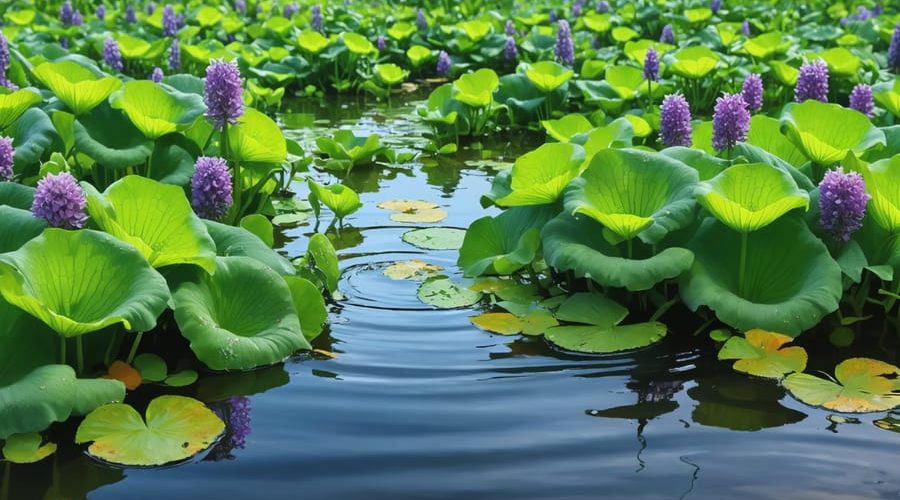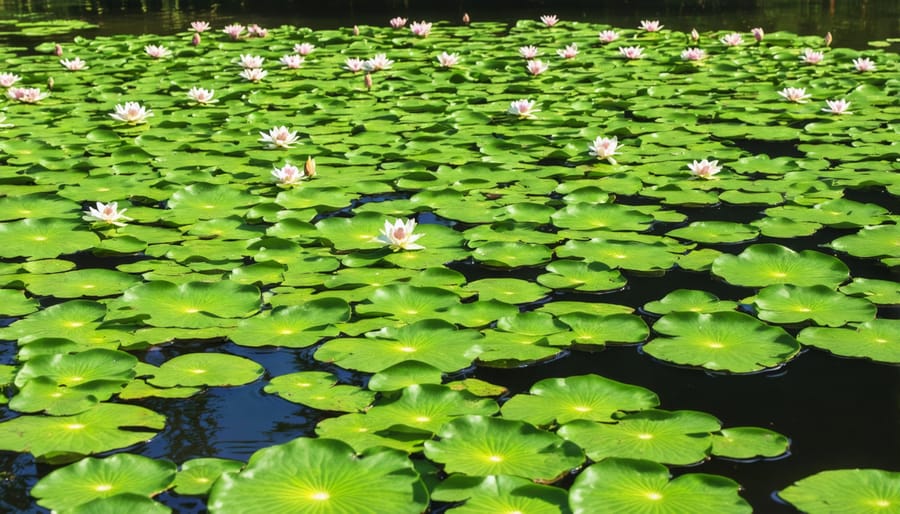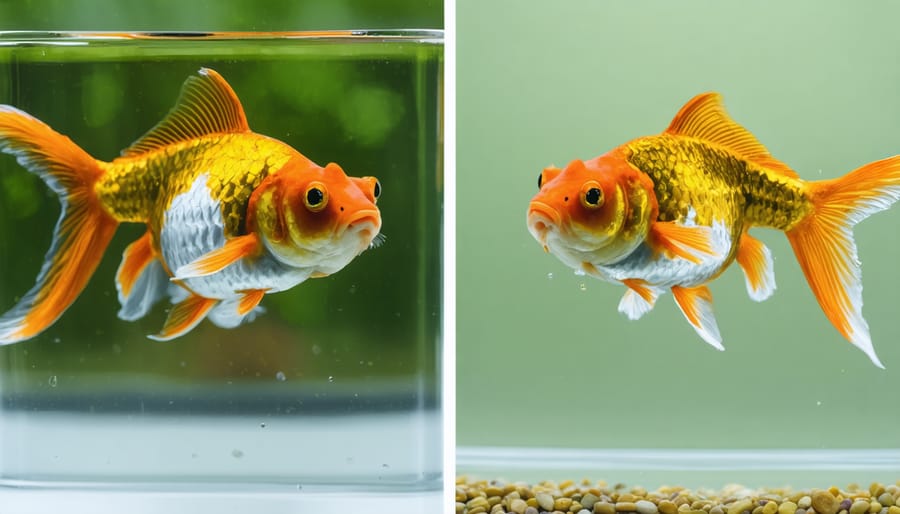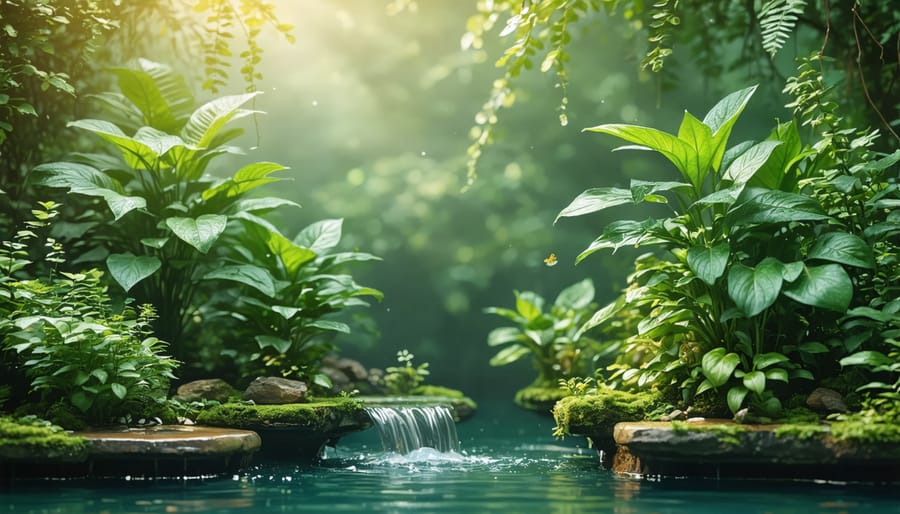
Dangerous Aquatic Invaders Threatening Your Pond (And How to Stop Them)
Invasive aquatic species threaten the delicate balance of our waterways, turning peaceful ponds into battlegrounds for native wildlife survival. From the aggressive zebra mussel that clogs water intakes to the fast-spreading water hyacinth that chokes out beneficial plants, the battle against invasive pond plants requires vigilance and quick action. These unwanted guests arrive through seemingly innocent paths – hitching rides on boat hulls, mixing into water garden plants, or spreading through flood waters. But don’t worry – armed with knowledge and the right prevention strategies, you can protect your pond while maintaining its natural beauty. Let’s explore the most common aquatic invaders threatening North American waters and learn practical steps to keep them at bay. Whether you’re a seasoned pond owner or just getting started, understanding these species is your first line of defense in maintaining a healthy aquatic ecosystem.
Plant Invaders That Can Overtake Your Pond
Water Hyacinth: The Beautiful Menace
Water hyacinth might look stunning with its lavender blooms and glossy leaves, but don’t let its beauty fool you! This floating plant is one of the most aggressive aquatic invaders worldwide, capable of doubling its population in just two weeks under ideal conditions.
Originally from South America, water hyacinth has become a nightmare for pond owners and lake managers alike. Picture this: a single plant can quickly transform into a thick mat covering your entire pond surface, blocking sunlight and depleting oxygen levels for fish and other aquatic life below.
The problems don’t stop there. These floating menaces can clog water pumps, block boat traffic, and make fishing impossible. Their dense root systems trap sediment and create perfect breeding grounds for mosquitoes. Plus, when large colonies die off, the decomposing plant material can seriously harm water quality.
Control methods include physical removal (pulling them out by hand or using mechanical harvesters), biological control with specific insects, and chemical treatments as a last resort. Prevention is your best bet – never introduce water hyacinth to your pond, no matter how pretty it looks in photos!
If you spot water hyacinth in local waterways, report it to your state’s environmental agency immediately. Remember, what starts as one attractive plant can quickly become an expensive and time-consuming problem to solve.

Duckweed and Salvinia: Tiny but Troublesome
Don’t let their tiny size fool you – duckweed and salvinia are among the most troublesome floating plants you might encounter in your pond. These fast-growing invaders can quickly transform a crystal-clear water feature into a sea of green dots seemingly overnight!
Duckweed, which looks like miniature floating leaves, can double its population in just 36 hours under ideal conditions. While native duckweed species exist, invasive varieties can quickly overtake a pond, blocking sunlight and depleting oxygen levels for fish and other aquatic life.
Salvinia, often called water fern, is equally problematic. Its fuzzy, oval-shaped leaves float on the water’s surface, forming dense mats that can be several inches thick. The most aggressive species, Giant Salvinia, can completely cover a pond’s surface in just a few weeks, making it impossible for other plants to survive.
Both these tiny terrors spread easily – hitching rides on birds’ feet, garden equipment, or even your pond maintenance tools. To prevent their spread, always clean your equipment thoroughly between ponds and avoid transferring water or plants from potentially infested sources. If you spot either of these in your pond, removing them manually with a fine net can help, but you’ll need to be diligent as even a few remaining plants can quickly repopulate.
Fish Species That Don’t Play Nice
Common Carp and Koi Gone Wild
Common carp and koi might look beautiful in ornamental ponds, but when these fish escape or are released into natural waterways, they can wreak havoc on local ecosystems. These fish, originally from Asia, are now among North America’s most widespread aquatic invaders, creating problems in lakes, rivers, and wetlands across the continent.
When these fish feed, they stir up bottom sediments, making water cloudy and uprooting aquatic plants. This behavior destroys habitat for native fish and wildlife while reducing water quality. A single large carp can disturb several square feet of riverbed in just a few minutes of feeding!
The impact goes beyond murky waters. Carp and koi compete with native fish for food, eat fish eggs, and can introduce diseases to wild fish populations. They’re incredibly resilient and reproduce rapidly – a female carp can lay up to 2 million eggs annually!
For pond owners, it’s crucial to prevent these fish from escaping during floods or through connected waterways. Installing barriers, proper pond design, and never releasing unwanted fish into natural waters are essential steps in being a responsible water gardener. Remember, what starts as a beautiful addition to your pond could become an environmental nightmare if it reaches natural waters.
Goldfish: Not as Innocent as They Look
Those cute little goldfish you had as a childhood pet might not be so innocent after all! When released into outdoor ponds and waterways, goldfish can become unexpected troublemakers. These seemingly harmless fish can grow to shocking sizes – sometimes reaching over 12 inches long – when freed from their bowl constraints.
In the wild, goldfish are aggressive feeders that stir up sediment while searching for food. This disrupts native plants and decreases water clarity. They also compete with local fish species for food and resources, often outcompeting them thanks to their hardy nature and ability to survive in low-oxygen conditions.
Even worse, goldfish reproduce rapidly in outdoor environments. A single pair can quickly multiply into hundreds, overwhelming the ecosystem. They’re known to eat fish eggs, aquatic insects, and native vegetation, dramatically altering the natural balance of ponds and lakes.
Several countries and states now classify goldfish as invasive species due to the havoc they wreak on local waterways. If you can no longer care for your pet goldfish, never release it into natural waters. Instead, find it a new home through a local pet store or aquarium society. Remember, a moment of kindness to your pet fish could lead to years of ecological trouble!

Preventing Invasive Species in Your Pond
Smart Plant Selection and Quarantine
Making smart choices when selecting aquatic plants is your first line of defense to keep your water garden pest-free. Start by purchasing plants from reputable local nurseries that specialize in aquatic species. These establishments typically maintain strict quality control and can verify that their plants are native or approved non-invasive varieties.
Before adding any new plant to your water garden, set up a quarantine tank or container. This simple step helps prevent unwanted hitchhikers from entering your main water feature. Keep new plants isolated for at least two weeks, during which you should:
• Carefully inspect leaves, stems, and roots for snails, eggs, or unusual growth
• Gently rinse plants with clean water to remove any debris
• Remove any unhealthy or dying portions
• Check the water daily for signs of pest activity
When selecting plants, stick to species that are well-documented in your region and approved by local authorities. Avoid plants advertised as “fast-spreading” or “aggressive growers” – these terms often signal potentially invasive characteristics. If you’re unsure about a particular species, consult your local extension office or water garden community for guidance.
Remember, even common aquatic plants like water hyacinth or yellow flag iris can become problematic if not managed properly. Choose varieties that match your pond’s size and your maintenance capabilities.

Responsible Fish Keeping Practices
Being a responsible fish keeper is crucial in preventing the spread of aquatic invasive species. Start by thoroughly researching any fish species before adding them to your pond or water feature. Always purchase from reputable sellers who follow responsible pond management practices and can verify the origin of their stock.
Never release unwanted fish into natural waterways – this is often how invasive species establish themselves. If you can no longer care for your fish, contact local aquarium societies, pet stores, or fellow pond enthusiasts who might adopt them. Some retailers even offer take-back programs for unwanted aquatic pets.
When adding new fish to your pond, quarantine them for at least two weeks in a separate container. This helps prevent the introduction of diseases and allows you to observe any concerning behaviors. Regular monitoring of your pond’s inhabitants helps catch potential problems early.
Keep detailed records of your fish population, including species names, acquisition dates, and any health observations. This documentation can be invaluable if issues arise and helps maintain a balanced ecosystem. Remember to avoid overcrowding, as this can stress fish and lead to health problems.
If you spot unusual fish behavior or suspect an invasive species, contact your local extension office or fish and wildlife department immediately. Quick action can prevent larger environmental impacts.
As pond enthusiasts and responsible water gardeners, we all play a crucial role in protecting our local ecosystems from aquatic invasive species. By understanding the threats posed by invaders like water hyacinth, zebra mussels, and giant salvinia, we can take proactive steps to keep our water features both beautiful and environmentally friendly.
Remember, prevention is always easier than control. Make it a habit to inspect and clean your equipment, choose native plants whenever possible, and properly dispose of any unwanted aquatic plants or animals. If you’re purchasing new additions for your pond, always buy from reputable sources and research species carefully before introducing them to your water garden.
By staying vigilant and following proper maintenance practices, we can enjoy our ponds while protecting our natural waterways. Share your knowledge with fellow pond owners, and don’t hesitate to reach out to local extension offices or conservation groups if you spot suspicious species. Together, we can maintain healthy, balanced water gardens that enhance our outdoor spaces without harming the environment.
Most importantly, view your role as a pond owner as a stewardship responsibility. Your careful attention to preventing invasive species not only protects your investment but also contributes to the broader effort of preserving our native aquatic ecosystems for future generations to enjoy.
